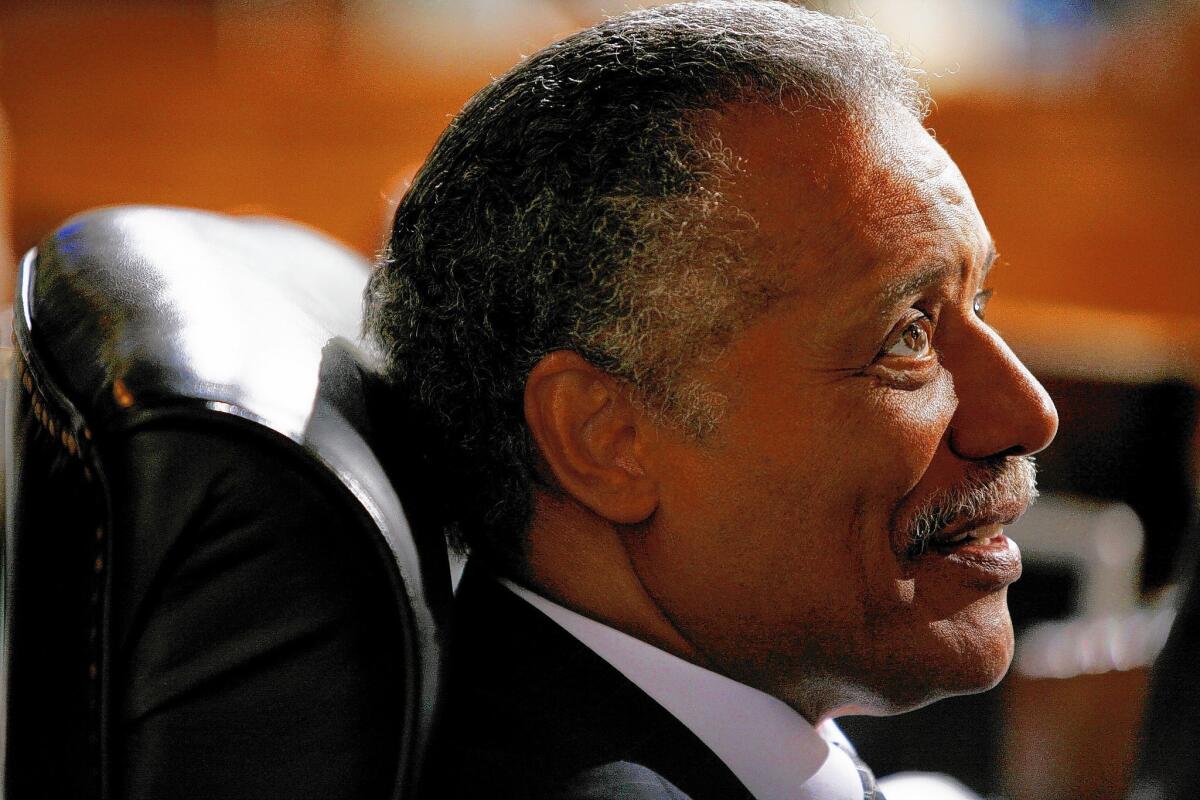L.A. apartment tenants would pay full quake retrofit costs under plan

A Los Angeles City Council member wants to allow owners who seismically retrofit apartment buildings to pass on the costs to tenants.
Councilman Bernard C. Parks said he wants the city to explore exempting these apartment owners from the city’s rent-control law as part of a larger effort by city officials to strengthen thousands of buildings vulnerable to collapse during a major earthquake.
Under existing laws, only 50% of the cost of major apartment rehabilitation projects can be passed through to tenants, Parks said. Parks wants city staff to evaluate passing through all the costs to tenants but do it “over a reasonable period of time.”
FULL COVERAGE: California earthquakes
The idea marks a new front in the decades-long debate in Los Angeles and elsewhere about who should pay for retrofitting dangerous buildings. Twenty years ago, the upper floors of the Northridge Meadows apartment complex collapsed during the Northridge earthquake, killing 16 residents on the lower floor.
Los Angeles officials have known about the dangers of older concrete and wooden apartment buildings for years, but concerns about costs killed earlier efforts to require retrofits of privately owned buildings. Many owners say they shouldn’t have to pay for expensive fixes on their own.
The council is already looking into a state bond measure that would help owners pay to seismically retrofit their buildings. But Parks said the city should first consider other options.
REMEMBERING THE NORTHRIDGE QUAKE: 20 years later
“Before you start … looking to the state for funding, you should first look at your own city ordinances and see if there might be a simpler solution,” Parks said. “You don’t ask for bond money to keep your property in tiptop shape.”
A Los Angeles tenants-rights group said tenants cannot afford to foot the entire bill for seismic upgrades.
“This motion is like a direct attack on low-income and working renters in this city. It’s ludicrous,” said Larry Gross, executive director of the Coalition for Economic Survival.
Gross said tenants “should not bear the full burden of any earthquake retrofit costs while giving landlords a complete pass.”
Apartment owners groups welcomed Parks’ idea but added officials should still pursue other ways of helping pay for the costs. Jim Clarke, chief executive of the Apartment Assn. of Greater Los Angeles, said a government bond measure should be pursued, as well as grant money from the Federal Emergency Management Agency.
“We wouldn’t want to see one particular group bear the burden,” Clarke said.
In San Francisco, officials waive rent control limits on rent increases when owners seismically retrofit their apartment buildings. Owners are allowed to pass along the full retrofit costs to tenants, including those on rent control, over a 20-year period. Extremely low-income tenants, such as those on food stamps, are exempt from the rent increases.
The San Francisco Board of Supervisors last year required about 3,000 wooden apartment buildings with weak ground floors to be strengthened.
They house more than 55,000 residents, and officials warned the loss of so much housing at once could force displaced residents to move as far away as the Central Valley, where housing is plentiful. Their destruction would also take thousands of rent-controlled apartments off the market permanently.
The San Francisco law makes owners responsible for completing the retrofits. Owners can finance them with private loans or city loans that could be repaid through additional property taxes.
After the retrofit, tenants would see monthly rent increases of probably $8 to $50 a month if they were not classified as very low income. Retrofitting an apartment building in San Francisco is estimated to cost $60,000 to $130,000.
Getting agreement on the deal from tenant and owner groups was challenging, and the city could not afford to help pay for the retrofits, San Francisco Mayor Ed Lee said in an interview last year.
Not everyone was happy about the law, but Lee said there was consensus that the safety of residents was more important than arguing “we can’t stand for any rent increase.”
“We lose 55,000 lives if we don’t do anything,” Lee said.
Landlord groups such as the California Apartment Assn. ultimately backed the mayor’s plan. Beverly Kenworthy, executive director of the association’s Los Angeles branch, said owners earn below-market rent on rent-controlled apartments. Passing through seismic retrofit costs to tenants is “one way that owners would be able to comply” with a mandatory seismic retrofit ordinance.
“You can have a mandate, but if there’s no mechanism for landlords to comply, this issue is not going to be addressed,” Kenworthy said. But she added the city should pursue other funding ideas as well.
Other cities are also dealing with who should pay for mandatory seismic retrofits. In Berkeley, owners must apply for permission to the city’s rent board to raise rents beyond the rent control limit.
Santa Monica recently decided to resume enforcement of its seismic retrofit program. Some property owners are also asking the city to pass through retrofit costs to tenants.
Wooden apartment structures that are built over carports and held up with slender columns leave the upper floors at risk of crashing into ground-floor apartments during shaking.
Besides the collapse of the Northridge Meadows apartment building, about 200 such structures were damaged during the 1994 Northridge earthquake.
Older concrete buildings are also at risk of collapse. In October, The Times reported that by the most conservative estimate, as many as 50 of the more than 1,000 concrete buildings in the city built before 1976 would collapse in a major earthquake, exposing thousands to injury or death.
Concrete buildings may look strong, but many are vulnerable to the sideways movement of a major earthquake because they don’t have enough steel reinforcement to hold columns in place.
There are other efforts underway to help owners pay for retrofits. Councilman Mitch Englander is working with Assemblyman Adrin Nazarian (D-Sherman Oaks) to give owners a tax break on seismic retrofits.
But Nazarian was unsure whether Sacramento would find a quick solution.
“How can we address the needs without putting a dent in the state revenue?” Nazarian said in an interview last month.
Other pressing statewide needs, such as water, education and transportation, would compete against a quake bond measure.
“I don’t know if a bond would be an appropriate way to go about it,” Nazarian said.
Parks’ motion will be forwarded to a City Council committee for consideration.
More to Read
Sign up for Essential California
The most important California stories and recommendations in your inbox every morning.
You may occasionally receive promotional content from the Los Angeles Times.












